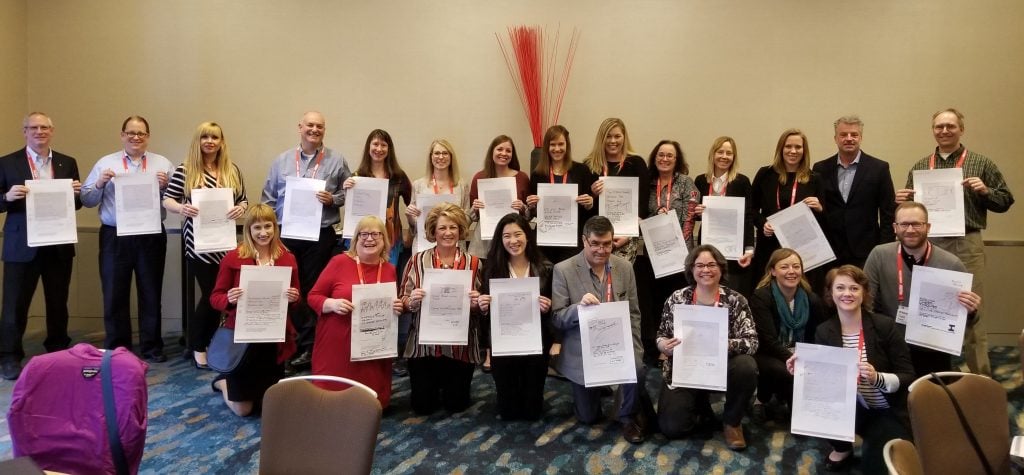 Today is the last regular day of classes at Michigan Tech for the 2017-2018 academic year. Next week is Finals Week, which then leads into Commencement on Saturday, May 5. How time flies when you are having fun!
Today is the last regular day of classes at Michigan Tech for the 2017-2018 academic year. Next week is Finals Week, which then leads into Commencement on Saturday, May 5. How time flies when you are having fun!
This is always a busy time of year for me, although having been in this job for 10 years now I have come to expect it and plan for it. What was a little harder to plan for this year was the added stress of wrapping up the work of the Computing and Information Sciences Working Group, and the launch of our new online MS program in partnership with Keypath Education. Just to top it off I had a mild case of the flu which had me going from one meeting to the next like the walking dead. I’m not complaining though – what doesn’t kill me makes me stronger, and I am grateful and energized by having meaningful work to do.
Michigan Tech students, especially graduating seniors, celebrate the last day of classes with a tradition we call the Senior Walk, a pub crawl that makes its way from Hancock to Houghton in the late afternoon and evening. I am on a bit of a Senior Walk myself, on my way to California with my wife to spend time with good friends in the wine country near Healdsburg. It’s a short trip, and I will follow that up by heading to Yuma, Arizona, to offer a little moral support to our students in the GM/SAE AutoDrive Challenge as they put their autonomous vehicle through the Year 1 Competition. I will make it back just in time for some year-end meetings, and of course commencement.
Last week is what we call Week 13 in the academic calendar, the culmination of all our Senior Design and Enterprise projects. We followed our usual schedule, with the student presentations all morning on Thursday, the Design Expo on Thursday afternoon, and the ECE Senior Banquet in the evening. The ECE External Advisory Committee was in town, serving as judges for the projects and presentations. The entire ECE faculty gets in the act too; I ask everyone to sit in on at least two presentations and provide written feedback.
At the Senior Banquet we give out a number of awards to our top students, our top projects, and one special faculty member.
Following a tradition we started last year, we recognized all the student volunteers who help with Fall Open House, Spring Preview Day, departmental tours for prospective high school students, calling campaigns, and similar activities. These students act as ambassadors for Michigan Tech and the ECE Department. They believe in what we are trying to do here with our educational programs, and do an outstanding job of communicating that enthusiasm to others. We are deeply grateful to them for all they do.

Each year we give three awards to top undergraduate students in the ECE Department. The first is the ECE Departmental Scholar Award. It is given to a student who will have senior status next academic year, and represents the best in student scholarship in the department. The Departmental Scholar is our nomination for the Provost’s Award for Scholarship, a university-wide award that is announced the following Friday. The winner of ECE Departmental Scholar for 2018 is Elizabeth (Liz) Adams. Liz is an electrical engineering major with a departmental GPA of 3.92. She participates in the LEAP program, where she served as a near-peer mentor for students in Engineering Fundamentals 1101, answering students questions and teaching a one-hour lesson each week. Other activities at Michigan Tech include being a member of the Society of Women Engineers, Vice-President of the Fencing Club, and a project manager for Concrete Canoe. Faculty members Mike Roggemann and Kit Cischke both had high praise for Liz’ academic ability and intellectual curiosity.

Our second student award is the ECE Woman of Promise. The goal of this program, which is connected to the Presidential Council of Alumnae, is to recognize women at Michigan Tech who go “above and beyond” what is expected of them in terms of being a well-rounded student – those who have demonstrated academic achievement, campus and community leadership, good citizenship, and creativity. This year’s ECE Woman of Promise is Christine Cauley. Christine is an electrical engineering major with a GPA of 3.46. She was nominated by ECE academic advisor Judy Donahue, who writes “Christine is a cheerful ambassador of the ECE Department as she has helped with the Fall Open House department tour. She is a member of the Wireless Communications Enterprise, and is a Project Leader for her team, which worked on a bird-window collision sensor. She is a member of the Blue Key National Honor Society and Co-Chair for the Queens Committee. Christine was a guest speaker for the Michigan Tech’s Fall Open House event. She goes above and beyond, demonstrating campus and community leadership while successfully pursuing the BSEE, and is deserving of the award.”

The third and final student award in the ECE Department is the Carl S. Schjonberg Award for Outstanding Undergraduate in the ECE Department. This award was established to honor a long-time faculty member in the ECE Department and is given to our top student, usually a graduating senior. The Schjonberg Award recipient for this year is Lanna Pirkola. Lanna is a 3rd-year senior with a departmental GPA of 4.0. She plans to graduate in December 2018, in only three and a half years. She has served on the departmental Undergraduate Advisory Board, and is a member of Eta Kappa Nu. She is a recipient of the Michigan Tech Presidential Scholarship of Distinction, and the Air Force Recruiting Service Mathematics and Science Award. She is an absolutely top-rate student who works very very hard and will make us proud when she enters the workforce. Congratulations Lanna!

The ECE External Advisory Committee awards the Larry Kennedy Industry Innovation Award to the top ECE student project, based on the project reports and presentations from earlier in the day. This year the top prize went to the project titled “Medical Device Tool One-Way Communication Emulator” sponsored by Stryker Medical. This is the second year in a row that a Stryker project has taken the top prize, so they certainly must be doing something right to inspire the students and give them something meaty to work on. Congratulations to advisor Trever Hassell and all the students on a job well done.

Although not part of the Senior Banquet festivities on that Thursday evening, this is a good place to mention how the ECE Department fared in the Michigan Tech Design Expo, which is a university-wide event held on Thursday afternoon in the MUB, where students set up posters describing their projects and explain their work to judges and other attendees. For the first time in as long as I can remember, an ECE Department project won the best Senior Design project! The project was “Performance and Protection Characterization of Plug and Play Solar Systems”, sponsored by Consumers Energy. The faculty advisor was Prof. Sumit Paudyal, and the student team was Lauren Clark, Erik Romanski, Gabe Simmering, and Jason Wesley. I couldn’t be more pleased with this result. The ECE project titled “Human Machine Interface (HMI) Anunciator Replacement” took Honorable Mention in the Senior Design Projects, and our Wireless Communication Enterprise, advised by Kit Cischke, took Third Place in the Enterprise category.
The final award for the Senior Banquet is the announcement by the students in Eta Kappa Nu of their choice for Professor of the Year. I am delighted to report that this year the students selected Prof. Sumit Paudyal. Sumit has made a name for himself in the past six years as an outstanding instructor, although that reputation is based primarily on his teaching in graduate courses in the power and energy program. With only a little exposure to our undergraduates through a senior-level power systems course, and his acting as advisor for the project that took the top prize in Design Expo, our undergraduates have immediately recognized what an enormous asset Prof. Paudyal is for the department. In addition to this award, this year Sumit won an NSF CAREER award and is being promoted to the rank of Associate Professor, with tenure. It’s an academic trifecta! On top of all that, Sumit and his wife Saru Bhattarai had their first baby this year! Sometimes the universe just lines everything up in the same direction at the same time. I am delighted for all the good things that are coming Sumit’s way, and proud to call him a member of the Michigan Tech ECE Department.

Next week (probably) – news from Arizona. To all our students – good luck with finals!
– Dan
Daniel R. Fuhrmann
Dave House Professor and Chair
Department of Electrical and Computer Engineering
Michigan Technological University


 This morning at 10am, with just the right amount of drama, suspense, and fanfare, the Michigan Tech Board of Trustees in a special meeting announced the selection of Dr. Richard J. Koubek as the 10th president of the University. Dr. Koubek will take office on July 1, 2018.
This morning at 10am, with just the right amount of drama, suspense, and fanfare, the Michigan Tech Board of Trustees in a special meeting announced the selection of Dr. Richard J. Koubek as the 10th president of the University. Dr. Koubek will take office on July 1, 2018.




 I am delighted and excited to announce the launch of a new venture in the Department of Electrical and Computer Engineering at Michigan Tech. In September 2018, the ECE Department, in partnership with the online education support company
I am delighted and excited to announce the launch of a new venture in the Department of Electrical and Computer Engineering at Michigan Tech. In September 2018, the ECE Department, in partnership with the online education support company